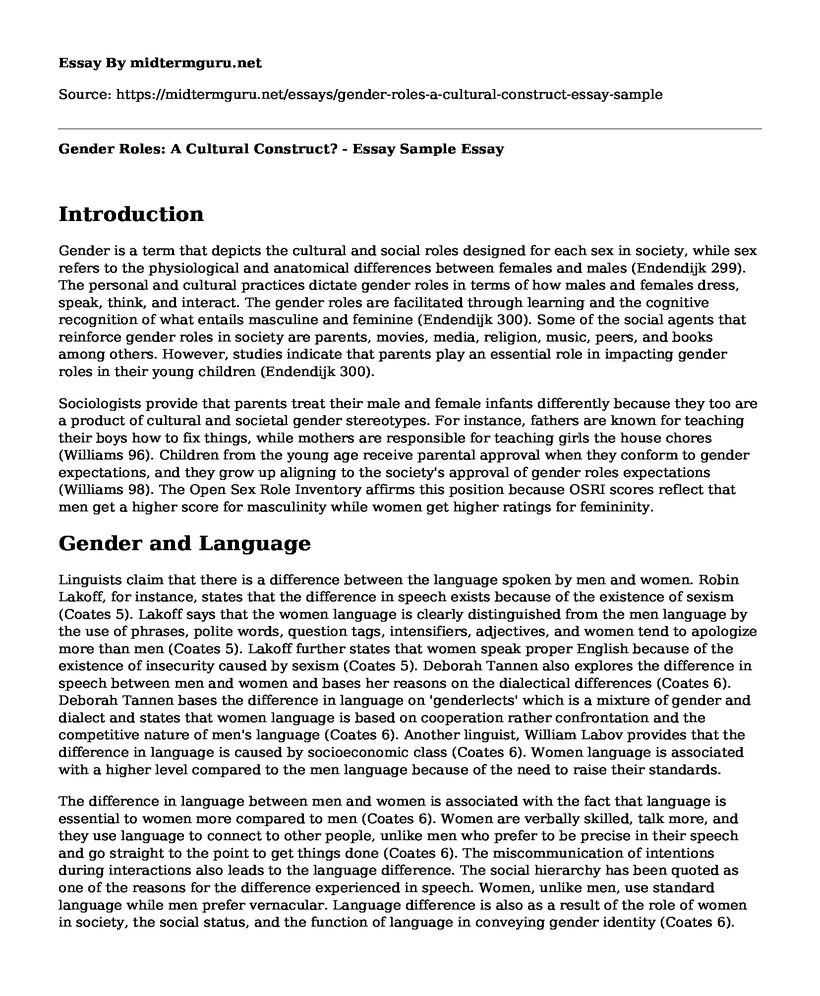Introduction
Gender is a term that depicts the cultural and social roles designed for each sex in society, while sex refers to the physiological and anatomical differences between females and males (Endendijk 299). The personal and cultural practices dictate gender roles in terms of how males and females dress, speak, think, and interact. The gender roles are facilitated through learning and the cognitive recognition of what entails masculine and feminine (Endendijk 300). Some of the social agents that reinforce gender roles in society are parents, movies, media, religion, music, peers, and books among others. However, studies indicate that parents play an essential role in impacting gender roles in their young children (Endendijk 300).
Sociologists provide that parents treat their male and female infants differently because they too are a product of cultural and societal gender stereotypes. For instance, fathers are known for teaching their boys how to fix things, while mothers are responsible for teaching girls the house chores (Williams 96). Children from the young age receive parental approval when they conform to gender expectations, and they grow up aligning to the society's approval of gender roles expectations (Williams 98). The Open Sex Role Inventory affirms this position because OSRI scores reflect that men get a higher score for masculinity while women get higher ratings for femininity.
Gender and Language
Linguists claim that there is a difference between the language spoken by men and women. Robin Lakoff, for instance, states that the difference in speech exists because of the existence of sexism (Coates 5). Lakoff says that the women language is clearly distinguished from the men language by the use of phrases, polite words, question tags, intensifiers, adjectives, and women tend to apologize more than men (Coates 5). Lakoff further states that women speak proper English because of the existence of insecurity caused by sexism (Coates 5). Deborah Tannen also explores the difference in speech between men and women and bases her reasons on the dialectical differences (Coates 6). Deborah Tannen bases the difference in language on 'genderlects' which is a mixture of gender and dialect and states that women language is based on cooperation rather confrontation and the competitive nature of men's language (Coates 6). Another linguist, William Labov provides that the difference in language is caused by socioeconomic class (Coates 6). Women language is associated with a higher level compared to the men language because of the need to raise their standards.
The difference in language between men and women is associated with the fact that language is essential to women more compared to men (Coates 6). Women are verbally skilled, talk more, and they use language to connect to other people, unlike men who prefer to be precise in their speech and go straight to the point to get things done (Coates 6). The miscommunication of intentions during interactions also leads to the language difference. The social hierarchy has been quoted as one of the reasons for the difference experienced in speech. Women, unlike men, use standard language while men prefer vernacular. Language difference is also as a result of the role of women in society, the social status, and the function of language in conveying gender identity (Coates 6).
Hacker Factor Gender Guesser
I have used the Hacker Factor Gender Guesser to determine my gender based on a document I have written. I have used more than 300 words, and the results indicate that for both informal and formal genre, the verdict was male and that is true. The system bases its prediction on factors such as experience, occupation, education level, author's age, and knowledge of the content presented. The system requires at least 300 words to determine word repetition because different gender writes with consistent styles.
Works Cited
Coates, Jennifer. Women, men and language: A sociolinguistic account of gender differences in language. Routledge, 2015.
Endendijk, Joyce J., et al. "Gender differences in child aggression: Relations with genderdifferentiated parenting and parents' genderrole stereotypes." Child development 88.1 (2017): 299-316. https://openaccess.leidenuniv.nl/bitstream/handle/1887/32778/Endendijk_150128_dissertation.pdf?sequence=16#page=112. Accessed 13 April 2019.
Williams, Joan C. "Deconstructing Gender [1989]." Feminist Legal Theory. Routledge, 2018. 95-123. https://repository.uchastings.edu/cgi/viewcontent.cgi?referer=https://scholar.google.com/&httpsredir=1&article=1835&context=faculty_scholarship. Accessed 13 April 2019.
Cite this page
Gender Roles: A Cultural Construct? - Essay Sample. (2022, Dec 26). Retrieved from https://midtermguru.com/essays/gender-roles-a-cultural-construct-essay-sample
If you are the original author of this essay and no longer wish to have it published on the midtermguru.com website, please click below to request its removal:
- Essay Sample on How the Society Views the Gender
- How to Navigate the Relationship - Essay Sample
- Article Analysis Essay on "Home Is Where the Han Is: A Korean American Perspective on the Los Angeles Upheavals"
- Glamour of Celebrity Lifestyles: A Media Construct? - Essay Sample
- Article Analysis Essay on The Importance of the Clan in Iraq
- Ethics in Communication: Ensuring Authentic Communication for Businesses - Essay Sample
- Faculty-Student Communication and Its Impact on Motivation and Trust - Essay Sample







